Input interpretation

N_2O_5 dinitrogen pentoxide ⟶ O_2 oxygen + N_2O_4 dinitrogen tetroxide
Balanced equation
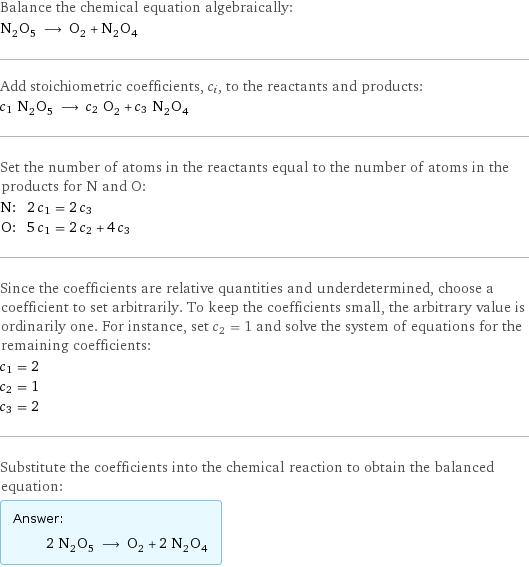
Balance the chemical equation algebraically: N_2O_5 ⟶ O_2 + N_2O_4 Add stoichiometric coefficients, c_i, to the reactants and products: c_1 N_2O_5 ⟶ c_2 O_2 + c_3 N_2O_4 Set the number of atoms in the reactants equal to the number of atoms in the products for N and O: N: | 2 c_1 = 2 c_3 O: | 5 c_1 = 2 c_2 + 4 c_3 Since the coefficients are relative quantities and underdetermined, choose a coefficient to set arbitrarily. To keep the coefficients small, the arbitrary value is ordinarily one. For instance, set c_2 = 1 and solve the system of equations for the remaining coefficients: c_1 = 2 c_2 = 1 c_3 = 2 Substitute the coefficients into the chemical reaction to obtain the balanced equation: Answer: | | 2 N_2O_5 ⟶ O_2 + 2 N_2O_4
Structures

⟶ +
Names

dinitrogen pentoxide ⟶ oxygen + dinitrogen tetroxide
Reaction thermodynamics
Enthalpy
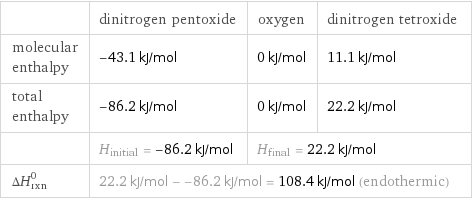
| dinitrogen pentoxide | oxygen | dinitrogen tetroxide molecular enthalpy | -43.1 kJ/mol | 0 kJ/mol | 11.1 kJ/mol total enthalpy | -86.2 kJ/mol | 0 kJ/mol | 22.2 kJ/mol | H_initial = -86.2 kJ/mol | H_final = 22.2 kJ/mol | ΔH_rxn^0 | 22.2 kJ/mol - -86.2 kJ/mol = 108.4 kJ/mol (endothermic) | |
Gibbs free energy
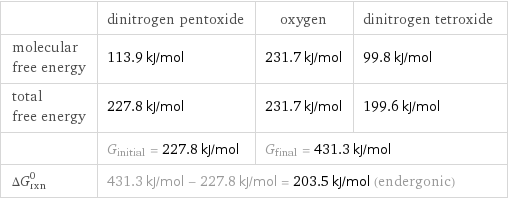
| dinitrogen pentoxide | oxygen | dinitrogen tetroxide molecular free energy | 113.9 kJ/mol | 231.7 kJ/mol | 99.8 kJ/mol total free energy | 227.8 kJ/mol | 231.7 kJ/mol | 199.6 kJ/mol | G_initial = 227.8 kJ/mol | G_final = 431.3 kJ/mol | ΔG_rxn^0 | 431.3 kJ/mol - 227.8 kJ/mol = 203.5 kJ/mol (endergonic) | |
Entropy
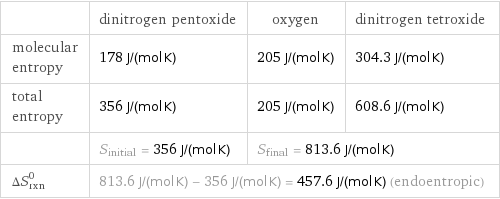
| dinitrogen pentoxide | oxygen | dinitrogen tetroxide molecular entropy | 178 J/(mol K) | 205 J/(mol K) | 304.3 J/(mol K) total entropy | 356 J/(mol K) | 205 J/(mol K) | 608.6 J/(mol K) | S_initial = 356 J/(mol K) | S_final = 813.6 J/(mol K) | ΔS_rxn^0 | 813.6 J/(mol K) - 356 J/(mol K) = 457.6 J/(mol K) (endoentropic) | |
Equilibrium constant
![Construct the equilibrium constant, K, expression for: N_2O_5 ⟶ O_2 + N_2O_4 Plan: • Balance the chemical equation. • Determine the stoichiometric numbers. • Assemble the activity expression for each chemical species. • Use the activity expressions to build the equilibrium constant expression. Write the balanced chemical equation: 2 N_2O_5 ⟶ O_2 + 2 N_2O_4 Assign stoichiometric numbers, ν_i, using the stoichiometric coefficients, c_i, from the balanced chemical equation in the following manner: ν_i = -c_i for reactants and ν_i = c_i for products: chemical species | c_i | ν_i N_2O_5 | 2 | -2 O_2 | 1 | 1 N_2O_4 | 2 | 2 Assemble the activity expressions accounting for the state of matter and ν_i: chemical species | c_i | ν_i | activity expression N_2O_5 | 2 | -2 | ([N2O5])^(-2) O_2 | 1 | 1 | [O2] N_2O_4 | 2 | 2 | ([N2O4])^2 The equilibrium constant symbol in the concentration basis is: K_c Mulitply the activity expressions to arrive at the K_c expression: Answer: | | K_c = ([N2O5])^(-2) [O2] ([N2O4])^2 = ([O2] ([N2O4])^2)/([N2O5])^2](../image_source/9c2152f0ca0ed812235d42cfca9ef6d0.png)
Construct the equilibrium constant, K, expression for: N_2O_5 ⟶ O_2 + N_2O_4 Plan: • Balance the chemical equation. • Determine the stoichiometric numbers. • Assemble the activity expression for each chemical species. • Use the activity expressions to build the equilibrium constant expression. Write the balanced chemical equation: 2 N_2O_5 ⟶ O_2 + 2 N_2O_4 Assign stoichiometric numbers, ν_i, using the stoichiometric coefficients, c_i, from the balanced chemical equation in the following manner: ν_i = -c_i for reactants and ν_i = c_i for products: chemical species | c_i | ν_i N_2O_5 | 2 | -2 O_2 | 1 | 1 N_2O_4 | 2 | 2 Assemble the activity expressions accounting for the state of matter and ν_i: chemical species | c_i | ν_i | activity expression N_2O_5 | 2 | -2 | ([N2O5])^(-2) O_2 | 1 | 1 | [O2] N_2O_4 | 2 | 2 | ([N2O4])^2 The equilibrium constant symbol in the concentration basis is: K_c Mulitply the activity expressions to arrive at the K_c expression: Answer: | | K_c = ([N2O5])^(-2) [O2] ([N2O4])^2 = ([O2] ([N2O4])^2)/([N2O5])^2
Rate of reaction
![Construct the rate of reaction expression for: N_2O_5 ⟶ O_2 + N_2O_4 Plan: • Balance the chemical equation. • Determine the stoichiometric numbers. • Assemble the rate term for each chemical species. • Write the rate of reaction expression. Write the balanced chemical equation: 2 N_2O_5 ⟶ O_2 + 2 N_2O_4 Assign stoichiometric numbers, ν_i, using the stoichiometric coefficients, c_i, from the balanced chemical equation in the following manner: ν_i = -c_i for reactants and ν_i = c_i for products: chemical species | c_i | ν_i N_2O_5 | 2 | -2 O_2 | 1 | 1 N_2O_4 | 2 | 2 The rate term for each chemical species, B_i, is 1/ν_i(Δ[B_i])/(Δt) where [B_i] is the amount concentration and t is time: chemical species | c_i | ν_i | rate term N_2O_5 | 2 | -2 | -1/2 (Δ[N2O5])/(Δt) O_2 | 1 | 1 | (Δ[O2])/(Δt) N_2O_4 | 2 | 2 | 1/2 (Δ[N2O4])/(Δt) (for infinitesimal rate of change, replace Δ with d) Set the rate terms equal to each other to arrive at the rate expression: Answer: | | rate = -1/2 (Δ[N2O5])/(Δt) = (Δ[O2])/(Δt) = 1/2 (Δ[N2O4])/(Δt) (assuming constant volume and no accumulation of intermediates or side products)](../image_source/b27dbb2a7986c90c42449a9dbd7db51d.png)
Construct the rate of reaction expression for: N_2O_5 ⟶ O_2 + N_2O_4 Plan: • Balance the chemical equation. • Determine the stoichiometric numbers. • Assemble the rate term for each chemical species. • Write the rate of reaction expression. Write the balanced chemical equation: 2 N_2O_5 ⟶ O_2 + 2 N_2O_4 Assign stoichiometric numbers, ν_i, using the stoichiometric coefficients, c_i, from the balanced chemical equation in the following manner: ν_i = -c_i for reactants and ν_i = c_i for products: chemical species | c_i | ν_i N_2O_5 | 2 | -2 O_2 | 1 | 1 N_2O_4 | 2 | 2 The rate term for each chemical species, B_i, is 1/ν_i(Δ[B_i])/(Δt) where [B_i] is the amount concentration and t is time: chemical species | c_i | ν_i | rate term N_2O_5 | 2 | -2 | -1/2 (Δ[N2O5])/(Δt) O_2 | 1 | 1 | (Δ[O2])/(Δt) N_2O_4 | 2 | 2 | 1/2 (Δ[N2O4])/(Δt) (for infinitesimal rate of change, replace Δ with d) Set the rate terms equal to each other to arrive at the rate expression: Answer: | | rate = -1/2 (Δ[N2O5])/(Δt) = (Δ[O2])/(Δt) = 1/2 (Δ[N2O4])/(Δt) (assuming constant volume and no accumulation of intermediates or side products)
Chemical names and formulas

| dinitrogen pentoxide | oxygen | dinitrogen tetroxide formula | N_2O_5 | O_2 | N_2O_4 name | dinitrogen pentoxide | oxygen | dinitrogen tetroxide IUPAC name | nitro nitrate | molecular oxygen |
Substance properties
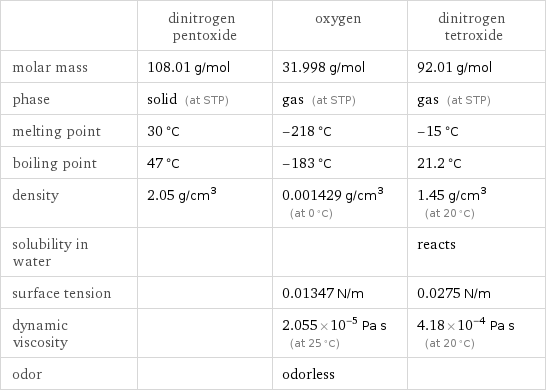
| dinitrogen pentoxide | oxygen | dinitrogen tetroxide molar mass | 108.01 g/mol | 31.998 g/mol | 92.01 g/mol phase | solid (at STP) | gas (at STP) | gas (at STP) melting point | 30 °C | -218 °C | -15 °C boiling point | 47 °C | -183 °C | 21.2 °C density | 2.05 g/cm^3 | 0.001429 g/cm^3 (at 0 °C) | 1.45 g/cm^3 (at 20 °C) solubility in water | | | reacts surface tension | | 0.01347 N/m | 0.0275 N/m dynamic viscosity | | 2.055×10^-5 Pa s (at 25 °C) | 4.18×10^-4 Pa s (at 20 °C) odor | | odorless |
Units
